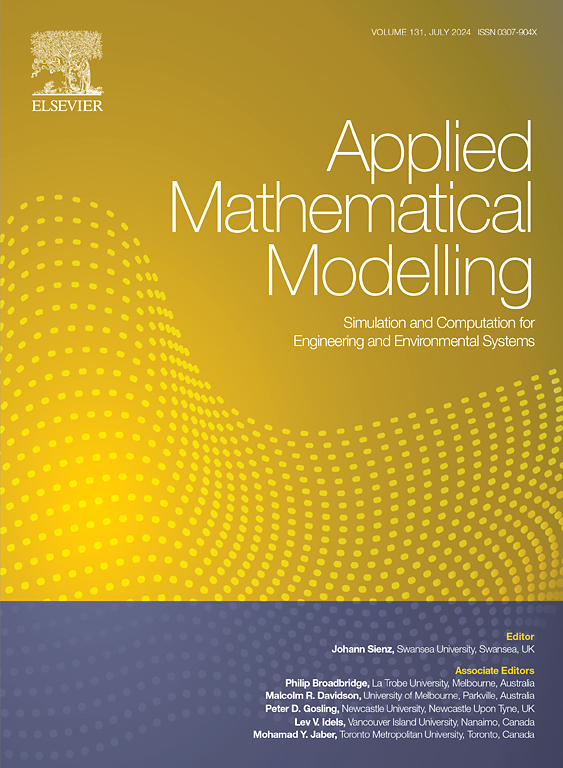Finite element simulations of the thermomechanically coupled responses of thermal barrier coating systems using an unconditionally stable staggered approach
IF 4.4
2区 工程技术
Q1 ENGINEERING, MULTIDISCIPLINARY
引用次数: 0
Abstract
Thermal barrier coating (TBC) systems have long been used in many engineering applications, such as jet engines and gas turbines. One pressing task is to evaluate their performance and integrity under long-term thermal cycles. This task requires an accurate and efficient time integration technique that is unconditionally stable, since large time steps are required to simulate TBC systems under long-term thermal effects. In this work, we present in detail several numerical methods to model the thermomechanically coupled responses of TBC systems, including a monolithic approach and two staggered approaches based on the isothermal split and the adiabatic split, respectively. We also demonstrate several finite element simulation techniques, such as the periodic boundary conditions and the adaptive mesh refinement, in the modeling of TBC systems. Through several numerical examples, we show that the staggered approach based on the adiabatic split preserves the unconditional stability of individual time integration techniques used for the mechanical phase and the thermal phase of the coupled problem. Moreover, the computational cost is significantly lower compared to the monolithic approach. This work provides an efficient time integration approach to model more complex behaviors of TBC systems under long-term thermal cycles.
使用无条件稳定交错法对隔热涂层系统的热机械耦合响应进行有限元模拟
热障涂层(TBC)系统长期以来一直用于喷气发动机和燃气轮机等许多工程应用领域。一项紧迫的任务是评估它们在长期热循环下的性能和完整性。这项任务需要精确、高效且无条件稳定的时间积分技术,因为在长期热效应下模拟 TBC 系统需要较大的时间步长。在这项工作中,我们详细介绍了几种用于模拟 TBC 系统热机械耦合响应的数值方法,包括一种单片方法和两种分别基于等温分割和绝热分割的交错方法。在 TBC 系统建模中,我们还展示了几种有限元模拟技术,如周期性边界条件和自适应网格细化。通过几个数值示例,我们表明基于绝热分割的交错方法保持了用于耦合问题机械阶段和热力阶段的单个时间积分技术的无条件稳定性。此外,与单片方法相比,计算成本明显降低。这项研究为模拟 TBC 系统在长期热循环下的更复杂行为提供了一种高效的时间积分方法。
本文章由计算机程序翻译,如有差异,请以英文原文为准。
求助全文
约1分钟内获得全文
求助全文
来源期刊

Applied Mathematical Modelling
数学-工程:综合
CiteScore
9.80
自引率
8.00%
发文量
508
审稿时长
43 days
期刊介绍:
Applied Mathematical Modelling focuses on research related to the mathematical modelling of engineering and environmental processes, manufacturing, and industrial systems. A significant emerging area of research activity involves multiphysics processes, and contributions in this area are particularly encouraged.
This influential publication covers a wide spectrum of subjects including heat transfer, fluid mechanics, CFD, and transport phenomena; solid mechanics and mechanics of metals; electromagnets and MHD; reliability modelling and system optimization; finite volume, finite element, and boundary element procedures; modelling of inventory, industrial, manufacturing and logistics systems for viable decision making; civil engineering systems and structures; mineral and energy resources; relevant software engineering issues associated with CAD and CAE; and materials and metallurgical engineering.
Applied Mathematical Modelling is primarily interested in papers developing increased insights into real-world problems through novel mathematical modelling, novel applications or a combination of these. Papers employing existing numerical techniques must demonstrate sufficient novelty in the solution of practical problems. Papers on fuzzy logic in decision-making or purely financial mathematics are normally not considered. Research on fractional differential equations, bifurcation, and numerical methods needs to include practical examples. Population dynamics must solve realistic scenarios. Papers in the area of logistics and business modelling should demonstrate meaningful managerial insight. Submissions with no real-world application will not be considered.
 求助内容:
求助内容: 应助结果提醒方式:
应助结果提醒方式:


